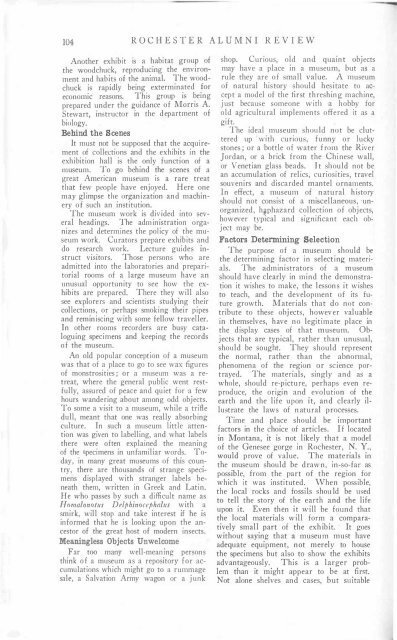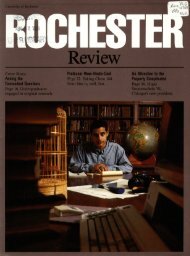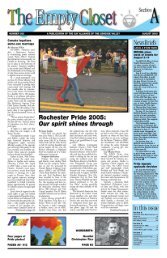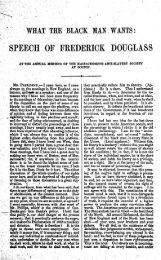Download PDF - University of Rochester Libraries
Download PDF - University of Rochester Libraries
Download PDF - University of Rochester Libraries
You also want an ePaper? Increase the reach of your titles
YUMPU automatically turns print PDFs into web optimized ePapers that Google loves.
104<br />
ROCHESTER ALUMNI REVIEW<br />
Another exhibit is a habitat group <strong>of</strong><br />
the woodchuck, reproducing the environ<br />
ment and habits <strong>of</strong> the animal. The wood<br />
chuck is rapidly being exterminated for<br />
economic reasons. This group is being<br />
prepared under the guidance <strong>of</strong> Morris A.<br />
Stewart, instructor in the department <strong>of</strong><br />
biology.<br />
Behind the Scenes<br />
It must not be supposed that the acqui rement<br />
<strong>of</strong> collections and the exhibits in the<br />
exhibition hall is the only function <strong>of</strong> a<br />
museum. To go behind the scenes <strong>of</strong> a<br />
great American museum is a rare treat<br />
that few people have enjoyed. Here one<br />
may glimpse the organization and machinery<br />
<strong>of</strong> such an institution.<br />
The museum work is divided into several<br />
headings. The administration organizes<br />
and determines the policy <strong>of</strong> the museum<br />
work. Curators prepare exhibits and<br />
do research work. Lecture guides instruct<br />
vIsItors. Those persons who are<br />
admitted into the laboratories and preparitorial<br />
rooms <strong>of</strong> a large museum have an<br />
unusual opportunity to see how the exhibits<br />
are prepared. There they will also<br />
see explorers and scientists studying their<br />
collections, or perhaps smoking their pipes<br />
and reminiscing with some fellow traveller.<br />
In other rooms recorders are busy cataloguing<br />
specimens and keeping the records<br />
<strong>of</strong> the museum.<br />
An old popular conception <strong>of</strong> a museum<br />
was that <strong>of</strong> a place to go to see wax figures<br />
<strong>of</strong> monstrosities j or a museum was a retreat,<br />
where the general public went restfully,<br />
assured <strong>of</strong> peace and quiet for a few<br />
hours wandering about among odd objects.<br />
To some a visit to a museum, while a triRe<br />
dull, meant that one was really absorbing<br />
culture. In such a museum little attention<br />
was given to labelling, and what labels<br />
there were <strong>of</strong>ten explained the meaning<br />
<strong>of</strong> the pecimens in unfamiliar words. Today,<br />
in many great museums <strong>of</strong> this country,<br />
there are thousands <strong>of</strong> strange specimens<br />
displayed with stranger labels beneath<br />
them, written in Greek and Latin.<br />
He who passes by such a difficult name as<br />
Homalonotus Delphinocephalus with a<br />
smirk, will stop and take interest if he is<br />
informed that he is looking upon the ancestor<br />
<strong>of</strong> the great host <strong>of</strong> modern insects.<br />
Meaningless Objects Unwelcome<br />
Far too many well-meaning persons<br />
think <strong>of</strong> a museum as a repository for accumulations<br />
which might go to a rummage<br />
sale, a Salvation Army wagon or a junk<br />
shop. Curious, old and quain t objects<br />
may have a place in a museum, but as a<br />
rule they are <strong>of</strong> small value. A museum<br />
<strong>of</strong> natural history should hesitate to accept<br />
a model <strong>of</strong> the fi rst thresh ing machine,<br />
just because someone with a hobby for<br />
old agricultural implements <strong>of</strong>fered it as a<br />
gift.<br />
The ideal museum should not be cluttered<br />
up with curious, funny or lucky<br />
stones j or a bottle <strong>of</strong> water from the River<br />
Jordan, or a brick from the Chinese wall,<br />
or Venetian glass beads. I t should not be<br />
an accumulation <strong>of</strong> relics, cu riosities, travel<br />
souvenirs 'and discarded mantel ornaments.<br />
In effect, a museum <strong>of</strong> natural history<br />
should not consist <strong>of</strong> a miscellaneous, ·unorganized,<br />
h,phazard collection <strong>of</strong> objects,<br />
however typical and significant each object<br />
may be.<br />
Factors Determining Selection<br />
The purpose <strong>of</strong> a museum should be<br />
the determining factor in selecting materials.<br />
The administrators <strong>of</strong> a museum<br />
should have clearly in mind the demonstration<br />
it wishes to make, the lessons it wishes<br />
to teach, and the development <strong>of</strong> its future<br />
growth. Materials that do not contribute<br />
to these objects, however valuable<br />
in themselves, have no legitimate place in<br />
the display cases <strong>of</strong> that museum. Objects<br />
that are typical, rather than unusual,<br />
should be sought. They should represent<br />
the no rmal, rather than the abnormal,<br />
phenomena <strong>of</strong> the region or science portrayed.<br />
The materials, singly and as a<br />
whole, should re-picture, perhaps even reproduce,<br />
the origin and evolution <strong>of</strong> the<br />
earth and the life upon it, and clearly illustrate<br />
the laws <strong>of</strong> natural processes.<br />
Time and place should be important<br />
factors in the choice <strong>of</strong> articles. If located<br />
in Montana, it is not likely that a model<br />
<strong>of</strong> the Genesee gorge in <strong>Rochester</strong>, N. Y.,<br />
would prove <strong>of</strong> value. The materials in<br />
the museum should be drawn, in-so-far as<br />
possible, from the part <strong>of</strong> the region for<br />
which it was instituted. When possible,<br />
the local rocks and fossils shou ld be used<br />
to tell the story <strong>of</strong> the earth and the life<br />
upon it. Even then it will be found that<br />
the local materials will form a comparatively<br />
small part <strong>of</strong> the exhibit. It goes<br />
without saying that a museum must have<br />
adequ ate equipment, not merely to house<br />
the specimens but also to shaw the exhibits<br />
advantageously. This is a larger problem<br />
than it might appear to be at first.<br />
Not alone shelves and cases, but suitable<br />
-
















